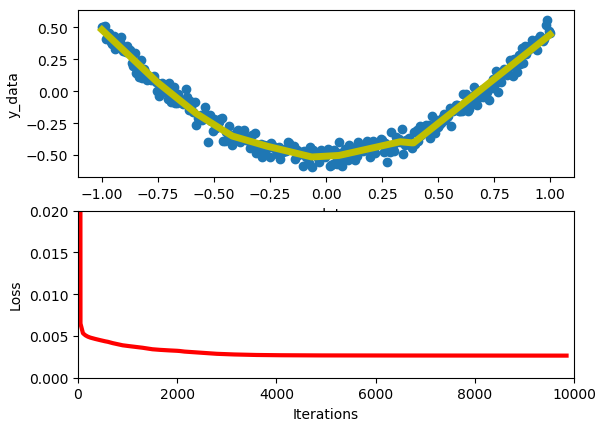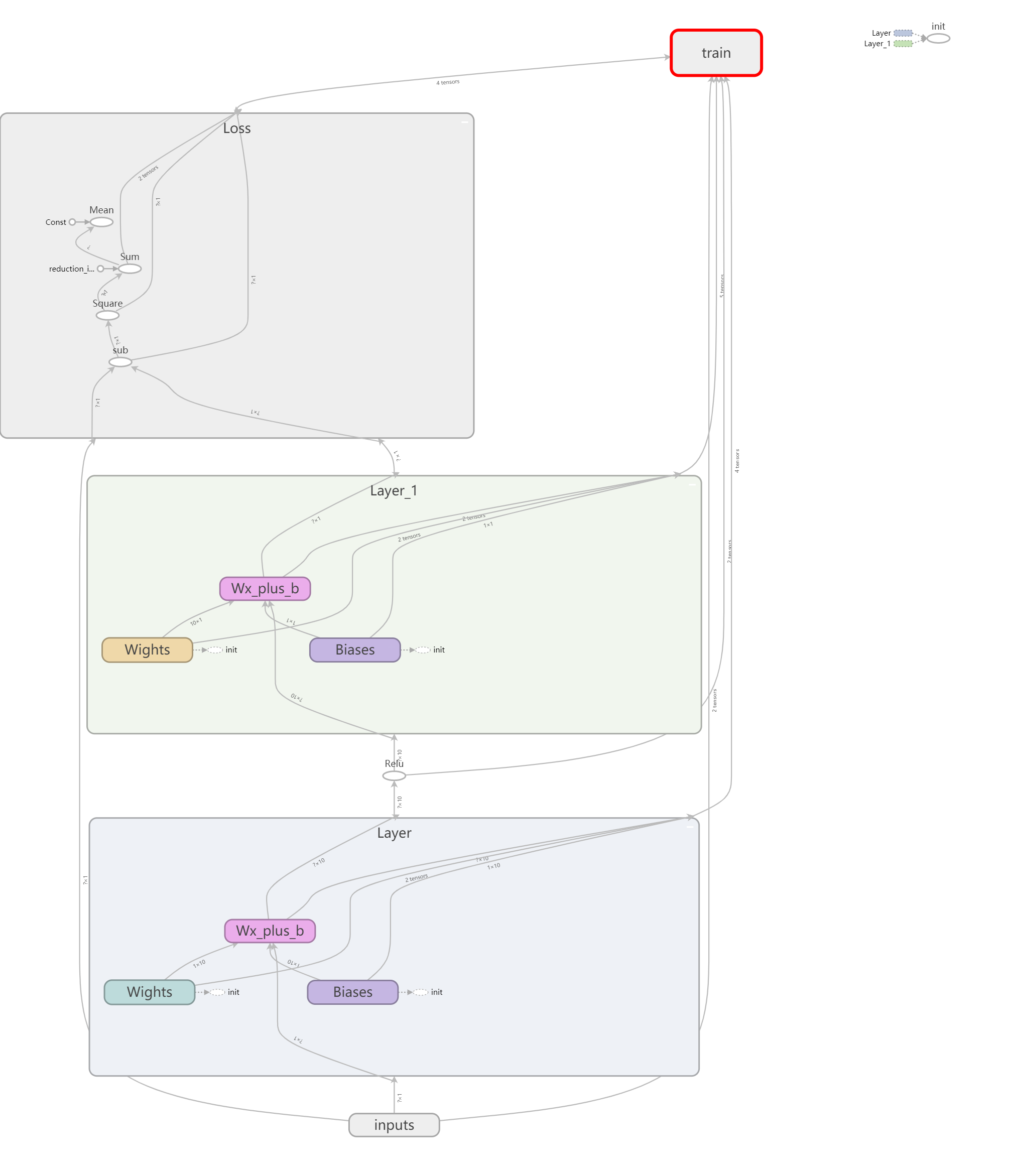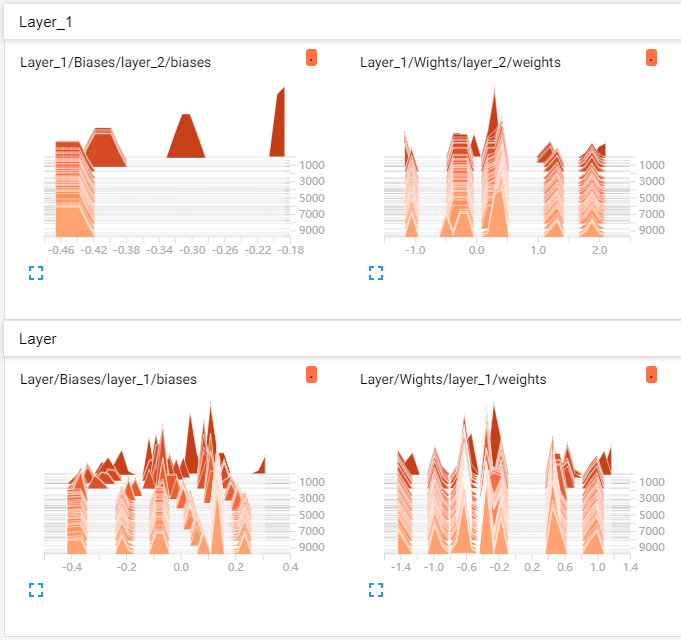bilibili莫烦tensorflow视频教程学习笔记
1.初次使用Tensorflow实现一元线性回归
# 屏蔽警告 import os os.environ['TF_CPP_MIN_LOG_LEVEL'] = '2' import numpy as np import tensorflow as tf # create dataset x_data = np.random.rand(100).astype(np.float32) y_data = x_data * 2 + 5 ### create tensorflow structure Start # 初始化Weights变量,由于是一元变量,所以w也只有一个 Weights = tf.Variable(tf.random_uniform([1],-1.0,1.0)) # 初始化bias,即截距b biases = tf.Variable(tf.zeros([1])) # 计算预测的y值,即y hat y = Weights*x_data+biases # 计算损失值 loss = tf.reduce_mean(tf.square(y-y_data)) # 优化器,这里采用普通的梯度下降,学习率alpha=0.5(0,1范围) optimizer = tf.train.GradientDescentOptimizer(0.5) # 使用优化器开始训练loss train = optimizer.minimize(loss) # tensorflow初始化变量 init = tf.global_variables_initializer() # create tensorflow structure End # 创建tensorflow的Session sess = tf.Session() # 激活initialize,很重要 sess.run(init) # 运行两百轮 for step in range(201): # 执行一次训练 sess.run(train) # 每20轮打印一次Wights和biases,看其变化 if step % 20 ==0: print(step,sess.run(Weights),sess.run(biases))
os.environ['TF_CPP_MIN_LOG_LEVEL'] = '2' 解释:
TF_CPP_MIN_LOG_LEVEL = 0:0为默认值,输出所有的信息,包含info,warning,error,fatal四种级别
TF_CPP_MIN_LOG_LEVEL = 1:1表示屏蔽info,只显示warning及以上级别
TF_CPP_MIN_LOG_LEVEL = 2:2表示屏蔽info和warning,显示error和fatal(最常用的取值)
TF_CPP_MIN_LOG_LEVEL = 3:3表示只显示fatal
2.Tensorflow基础 基本流程
# 导入tensorflow,安装的GPU版本,则默认使用GPU import tensorflow as tf # 定义两个矩阵常量 matrix1 = tf.constant([[3, 3], [2, 4]]) matrix2 = tf.constant([[1, 2], [5, 5]]) # 矩阵乘法,相当于np.dot(mat1,mat2) product = tf.matmul(matrix1, matrix2) # 初始化 init = tf.global_variables_initializer() # 使用with来定义Session,这样使用完毕后会自动sess.close() with tf.Session() as sess: # 执行初始化 sess.run(init) # 打印结果 result = sess.run(product) print(result)
3.tensorflow基础 变量、常量、传值
import tensorflow as tf state = tf.Variable(0, name='counter') one = tf.constant(1) # 变量state和常量one相加 new_value = tf.add(state, one) # 将new_value赋值给state update = tf.assign(state, new_value) # 初始化全局变量 init = tf.global_variables_initializer() # 打开Session with tf.Session() as sess: # 执行初始化,很重要 sess.run(init) # 运行三次update for _ in range(3): sess.run(update) print(sess.run(state))
4.使用placeholder
import tensorflow as tf # 使用placeholder定义两个空间,用于存放float32的数据 input1 = tf.placeholder(tf.float32) input2 = tf.placeholder(tf.float32) # 计算input1和input2的乘积 output = tf.matmul(input1, input2) # 定义sess with tf.Session() as sess: # 运行output,并在run的时候喂入数据 print(sess.run(output, feed_dict={input1: [[2.0, 3.0]], input2: [[4.0], [2.0]]}))
5.定义一个层(Layer)
import tensorflow as tf # inputs是上一层的输出,insize是上一层的节点数,outsize是本层节点数,af是激活函数,默认 # 为线性激活函数,即f(x)=X def add_layer(inputs, in_size, out_size, activation_function=None): # 定义权重w,并且用随机值填充,大小为in_size*out_size Weights = tf.Variable(tf.random_normal([in_size, out_size])) # 定义变差bias,大小为1*out_size biases = tf.Variable(tf.zeros([1, out_size]) + 0.1) # 算出z=wx+b Wx_plus_b = tf.matmul(inputs, Weights) + biases # 如果激励函数为空,则使用线性激励函数 if activation_function is None: outputs = Wx_plus_b else: # 如果不为空,则使用激励方程activation_function() outputs = activation_function(Wx_plus_b) # 返回输出值 return outputs
6.手动创建一个简单的神经网络
(包含一个输入层、一个隐藏层、一个输出层)
import numpy as np import tensorflow as tf # 添加一个隐藏层 def add_layer(inputs, in_size, out_size, activation_function=None): Weights = tf.Variable(tf.random_normal([in_size, out_size])) biases = tf.Variable(tf.zeros([1, out_size]) + 0.1) Wx_plus_b = tf.matmul(inputs, Weights) + biases if activation_function is None: outputs = Wx_plus_b else: outputs = activation_function(Wx_plus_b) return outputs ### 准备数据 # 创建x_data,从-1到1,分成300份,然后添加维度,让其编程一个300*1的矩阵 x_data = np.linspace(-1, 1, 300)[:, np.newaxis] # 定义一个噪声矩阵,大小和x_data一样,数据均值为0,方差为0.05 noise = np.random.normal(0, 0.05, x_data.shape) # 按公式x^2-0.5计算y_data,并加上噪声 y_data = np.square(x_data) - 0.5 + noise # 定义两个placeholder分别用于传入x_data和y_data xs = tf.placeholder(tf.float32, [None, 1]) ys = tf.placeholder(tf.float32, [None, 1]) # 创建一个隐藏层,输入为xs,输入层只有一个节点,本层有10个节点,激励函数为relu l1 = add_layer(xs, 1, 10, activation_function=tf.nn.relu) # 创建输出层 prediction = add_layer(l1, 10, 1, activation_function=None) # 定义损失 loss = tf.reduce_mean(tf.reduce_sum(tf.square(ys - prediction), reduction_indices=[1])) # 使用梯度下降对loss进行最小化,学习率为0.01 train_step = tf.train.GradientDescentOptimizer(0.01).minimize(loss) # 初始化全局变量 init = tf.global_variables_initializer() # 创建Session with tf.Session() as sess: # 初始化 sess.run(init) # 运行10000轮梯度下降 for _ in range(10001): sess.run(train_step, feed_dict={xs: x_data, ys: y_data}) # 每50轮打印一下loss看是否在减小 if _ % 50 == 0: print(sess.run(loss, feed_dict={xs: x_data, ys: y_data}))
7.使用matplotlib可视化拟合情况、Loss曲线
import numpy as np import tensorflow as tf import matplotlib.pyplot as plt # 添加一个隐藏层 def add_layer(inputs, in_size, out_size, activation_function=None): Weights = tf.Variable(tf.random_normal([in_size, out_size])) biases = tf.Variable(tf.zeros([1, out_size]) + 0.1) Wx_plus_b = tf.matmul(inputs, Weights) + biases if activation_function is None: outputs = Wx_plus_b else: outputs = activation_function(Wx_plus_b) return outputs ### 准备数据 # 创建x_data,从-1到1,分成300份,然后添加维度,让其编程一个300*1的矩阵 x_data = np.linspace(-1, 1, 300)[:, np.newaxis] # 定义一个噪声矩阵,大小和x_data一样,数据均值为0,方差为0.05 noise = np.random.normal(0, 0.05, x_data.shape) # 按公式x^2-0.5计算y_data,并加上噪声 y_data = np.square(x_data) - 0.5 + noise # 定义两个placeholder分别用于传入x_data和y_data xs = tf.placeholder(tf.float32, [None, 1]) ys = tf.placeholder(tf.float32, [None, 1]) # 创建一个隐藏层,输入为xs,输入层只有一个节点,本层有10个节点,激励函数为relu l1 = add_layer(xs, 1, 10, activation_function=tf.nn.relu) # 创建输出层 prediction = add_layer(l1, 10, 1, activation_function=None) # 定义损失 loss = tf.reduce_mean(tf.reduce_sum(tf.square(ys - prediction), reduction_indices=[1])) # 使用梯度下降对loss进行最小化,学习率为0.01 train_step = tf.train.GradientDescentOptimizer(0.1).minimize(loss) # 初始化全局变量 init = tf.global_variables_initializer() # 创建Session with tf.Session() as sess: # 初始化 sess.run(init) # 创建图形 fig = plt.figure() # 创建子图,上下两个图的第一个(行,列,子图编号),用于画拟合图 a1 = fig.add_subplot(2, 1, 1) # 使用x_data,y_data画散点图 plt.scatter(x_data, y_data) plt.xlabel('x_data') plt.ylabel('y_data') # 修改图形x,y轴上下限x limit,y limit # plt.xlim(-2, 2) # plt.ylim(-1, 1) # 也可以用一行代码修改plt.axis([-2,2,-1,1]) plt.axis('tight') # 可以按内容自动收缩,不留空白 # 创建第二个子图,用于画Loss曲线 a2 = fig.add_subplot(2, 1, 2) # 可以使用这种方式来一次性设置子图的属性,和使用plt差不多 a2.set(xlim=(0, 10000), ylim=(0.0, 0.02), xlabel='Iterations', ylabel='Loss') # 使用plt.ion使其运行show()后不暂停 plt.ion() # 展示图片,必须使用show() plt.show() loss_list = [] index_list = [] # 运行10000轮梯度下降 for _ in range(10001): sess.run(train_step, feed_dict={xs: x_data, ys: y_data}) # 每50轮打印一下loss看是否在减小 if _ % 50 == 0: index_list.append(_) loss_list.append(sess.run(loss, feed_dict={xs: x_data, ys: y_data})) # 避免在图中重复的画线,线尝试删除已经存在的线 try: a1.lines.remove(lines_in_a1[0]) a2.lines.remove(lines_in_a2[0]) except Exception: pass prediction_value = sess.run(prediction, feed_dict={xs: x_data}) # 在a1子图中画拟合线,黄色,宽度5 lines_in_a1 = a1.plot(x_data, prediction_value, 'y-', lw=5) # 在a2子图中画Loss曲线,红色,宽度3 lines_in_a2 = a2.plot(index_list, loss_list, 'r-', lw=3) # 暂停一下,否则会卡 plt.pause(0.1)

注意:如果在pycharm运行上述代码,不能展示动态图片刷新,则需要进入File->setting,搜索Python Scientific,然后右侧去掉对勾(默认是勾选的),然后Apply,OK即可。
8.常用优化器Optimizers
train_step = tf.train.GradientDescentOptimizer(0.1).minimize(loss) train_step = tf.train.AdamOptimizer(learning_rate=0.01, beta1=0.9, beta2=0.999, epsilon=1e-8).minimize(loss) train_step = tf.train.MomentumOptimizer(learning_rate=0.01,momentum=0.9).minimize(loss) train_step = tf.train.RMSPropOptimizer(learning_rate=0.01).minimize(loss)
其中Adam效果比较好,但都可以尝试使用。
9.使用tensorboard绘网络结构图
import numpy as np import tensorflow as tf def add_layer(inputs, in_size, out_size, activation_function=None): # 每使用该函数创建一层,则生成一个名为Layer_n的外层框 with tf.name_scope('Layer'): # 内层权重框 with tf.name_scope('Wights'): Weights = tf.Variable(tf.random_normal([in_size, out_size])) # 内层Bias框 with tf.name_scope('Biases'): biases = tf.Variable(tf.zeros([1, out_size]) + 0.1) # 内层z(x,w,b)框 with tf.name_scope('Wx_plus_b'): Wx_plus_b = tf.matmul(inputs, Weights) + biases if activation_function is None: outputs = Wx_plus_b else: outputs = activation_function(Wx_plus_b) return outputs # 准备数据 x_data = np.linspace(-1, 1, 300)[:, np.newaxis] noise = np.random.normal(0, 0.05, x_data.shape) y_data = np.square(x_data) - 0.5 + noise # 使用tensorboard画inputs层 with tf.name_scope('inputs'): # 一个名为inputs的外层框 # x_input和y_input xs = tf.placeholder(tf.float32, [None, 1], name='x_input') ys = tf.placeholder(tf.float32, [None, 1], name='y_input') l1 = add_layer(xs, 1, 10, activation_function=tf.nn.relu) prediction = add_layer(l1, 10, 1, activation_function=None) # Loss框,其中包含计算Loss的各个步骤,例如sub,square,sum,mean等 with tf.name_scope("Loss"): loss = tf.reduce_mean(tf.reduce_sum(tf.square(ys - prediction), reduction_indices=[1])) # train框,其中包含梯度下降步骤和权重更新步骤 with tf.name_scope('train'): train_step = tf.train.GradientDescentOptimizer(0.1).minimize(loss) init = tf.global_variables_initializer() with tf.Session() as sess: # 将图写入文件夹logs writer = tf.summary.FileWriter('logs/') # 写入文件,名为events.out.tfevents.1561191707.06P2GHW85CAH236 writer.add_graph(sess.graph) sess.run(init)

注意:在运行代码后,在logs文件夹下生成 events.out.tfevents.1561191707.06P2GHW85CAH236 文件。
然后进入windows cmd,进入logs的上层文件夹,使用tensorboard --logdir logs即可打开web服务,然后复制给出的url地址进行访问。如图:

10.其他可视化,例如Weight、bias、loss等
import numpy as np import tensorflow as tf def add_layer(inputs, in_size, out_size, n_layer, activation_function=None): layer_name = 'layer_%d' % n_layer # 每使用该函数创建一层,则生成一个名为Layer_n的外层框 with tf.name_scope('Layer'): # 内层权重框 with tf.name_scope('Wights'): Weights = tf.Variable(tf.random_normal([in_size, out_size]), name='W') tf.summary.histogram(layer_name + '/weights', Weights) # 内层Bias框 with tf.name_scope('Biases'): biases = tf.Variable(tf.zeros([1, out_size]) + 0.1, name='B') tf.summary.histogram(layer_name + '/biases', biases) # 内层z(x,w,b)框 with tf.name_scope('Wx_plus_b'): Wx_plus_b = tf.matmul(inputs, Weights) + biases if activation_function is None: outputs = Wx_plus_b else: outputs = activation_function(Wx_plus_b) return outputs # 准备数据 x_data = np.linspace(-1, 1, 300)[:, np.newaxis] noise = np.random.normal(0, 0.05, x_data.shape) y_data = np.square(x_data) - 0.5 + noise # 使用tensorboard画inputs层 with tf.name_scope('inputs'): # 一个名为inputs的外层框 # x_input和y_input xs = tf.placeholder(tf.float32, [None, 1], name='x_input') ys = tf.placeholder(tf.float32, [None, 1], name='y_input') l1 = add_layer(xs, 1, 10, 1, activation_function=tf.nn.relu) prediction = add_layer(l1, 10, 1, 2, activation_function=None) # Loss框,其中包含计算Loss的各个步骤,例如sub,square,sum,mean等 with tf.name_scope("Loss"): loss = tf.reduce_mean(tf.reduce_sum(tf.square(ys - prediction), reduction_indices=[1])) tf.summary.scalar('Loss', loss) # train框,其中包含梯度下降步骤和权重更新步骤 with tf.name_scope('train'): train_step = tf.train.GradientDescentOptimizer(0.1).minimize(loss) init = tf.global_variables_initializer() merged = tf.summary.merge_all() with tf.Session() as sess: # 将图写入文件夹logs writer = tf.summary.FileWriter('logs/') # 写入文件,名为events.out.tfevents.1561191707.06P2GHW85CAH236 writer.add_graph(sess.graph) sess.run(init) # 运行10000轮梯度下降 for _ in range(10001): sess.run(train_step, feed_dict={xs: x_data, ys: y_data}) # 每50步在loss曲线中记一个点 if _ % 50 == 0: # 将merged和步数加入到总结中 result = sess.run(merged, feed_dict={xs: x_data, ys: y_data}) writer.add_summary(result, _)



11.使用tensorflow进行Mnist分类
import tensorflow as tf from tensorflow.examples.tutorials.mnist import input_data mnist = input_data.read_data_sets('MNIST_data', one_hot=True) # 添加一个隐藏层 def add_layer(inputs, in_size, out_size, activation_function=None): Weights = tf.Variable(tf.random_normal([in_size, out_size])) biases = tf.Variable(tf.zeros([1, out_size]) + 0.1) Wx_plus_b = tf.matmul(inputs, Weights) + biases if activation_function is None: outputs = Wx_plus_b else: outputs = activation_function(Wx_plus_b) return outputs # 测试准确度accuracy def compute_accuracy(v_xs, v_ys): # 引入全局变量prediction层 global prediction # 用v_xs输入数据跑一次prediction层,得到输出 y_pre = sess.run(prediction, feed_dict={xs: v_xs}) # 对比输出和数据集label,相同的为1,不同的为0 correct_prediction = tf.equal(tf.argmax(y_pre, 1), tf.argmax(v_ys, 1)) # 计算比对结果,可得到准确率百分比 accuracy = tf.reduce_mean(tf.cast(correct_prediction, tf.float32)) # 获取result,并返回 result = sess.run(accuracy, feed_dict={xs: v_xs, ys: v_ys}) return result # define placeholder for inputs on network xs = tf.placeholder(tf.float32, [None, 784]) # 手写数字的图片大小为28*28 ys = tf.placeholder(tf.float32, [None, 10]) # 输出为1*10的Onehot热独 # 只有一个输出层,输入为m*784的数据,输出为m*10的数据,m=100,因为batch_size取的是100 prediction = add_layer(xs, 784, 10, activation_function=tf.nn.softmax) # 使用交叉熵损失函数g(x)=-E[y*log(y_hat)],y为ys,例如[0,1,0,0,0,0,0,0,0,0],即数字为1, # 假设y_hat=[0.05,0.81,0.05,0.003,0.012,0.043,0.012,0.009,0.006,0.005], # 则g(x) = -(0*log0.05+1*log0.81+...+0*log0.005)=-log0.81=0.0915 # g(x)就是-tf.reduce_sum(ys * tf.log(prediction) # tf.reduce_mean(g(x),reduction_indices=[1])是对一个batch_size的样本取平均损失 # 相当于1/m * E(1 to m) [g(x)] cross_entropy = tf.reduce_mean(-tf.reduce_sum(ys * tf.log(prediction), reduction_indices=[1])) # 使用梯度下降,学习率为0.5来最小化cross_entropy train_step = tf.train.GradientDescentOptimizer(0.5).minimize(cross_entropy) # 定义Session sess = tf.Session() # 初始化 sess.run(tf.global_variables_initializer()) # 跑10000轮 for i in range(10001): # 使用SGD,batch_size=100 batch_x, batch_y = mnist.train.next_batch(100) # 执行一轮 sess.run(train_step, feed_dict={xs: batch_x, ys: batch_y}) # 每跑50轮打印一次准确度 if i % 50 == 0: # 训练集准确度 print('TRAIN acc:', compute_accuracy( batch_x, batch_y)) # 测试集准确度 print('TEST acc:', compute_accuracy( mnist.test.images, mnist.test.labels))
重点:关注代码中交叉熵损失函数的使用,多分类时的交叉熵损失函数为L(y_hat,y)=-E(j=1 to k) yj*log y_hatj,成本函数为J = 1/m E(i=1 to m) L(y_hati,yi)
12.使用Dropout避免过拟合
import tensorflow as tf from tensorflow.examples.tutorials.mnist import input_data mnist = input_data.read_data_sets('MNIST_data', one_hot=True) # 添加一个隐藏层 def add_layer(inputs, in_size, out_size, activation_function=None, keep_prob=1): Weights = tf.Variable(tf.random_normal([in_size, out_size])) biases = tf.Variable(tf.zeros([1, out_size]) + 0.1) Wx_plus_b = tf.matmul(inputs, Weights) + biases # 这里使用Dropout处理计算结果,默认keep_prob为1,具体drop比例按1-keep_prob执行 Wx_plus_b = tf.nn.dropout(Wx_plus_b, keep_prob) if activation_function is None: outputs = Wx_plus_b else: outputs = activation_function(Wx_plus_b) return outputs # 测试准确度accuracy def compute_accuracy(v_xs, v_ys): # 引入全局变量prediction层 global prediction # 用v_xs输入数据跑一次prediction层,得到输出 y_pre = sess.run(prediction, feed_dict={xs: v_xs}) # 对比输出和数据集label,相同的为1,不同的为0 correct_prediction = tf.equal(tf.argmax(y_pre, 1), tf.argmax(v_ys, 1)) # 计算比对结果,可得到准确率百分比 accuracy = tf.reduce_mean(tf.cast(correct_prediction, tf.float32)) # 获取result,并返回 result = sess.run(accuracy, feed_dict={xs: v_xs, ys: v_ys}) return result # define placeholder for inputs on network xs = tf.placeholder(tf.float32, [None, 784]) # 手写数字的图片大小为28*28 ys = tf.placeholder(tf.float32, [None, 10]) # 输出为1*10的Onehot热独 # 创建一个隐层,有50个节点,使用Dropout 30%来避免过拟合 l1 = add_layer(xs, 784, 50, activation_function=tf.nn.tanh, keep_prob=0.7) # 创建输出层,输入为m*784的数据,输出为m*10的数据,m=100,因为batch_size取的是100 prediction = add_layer(l1, 50, 10, activation_function=tf.nn.softmax) # 使用交叉熵损失函数g(x)=-E[y*log(y_hat)],y为ys,例如[0,1,0,0,0,0,0,0,0,0],即数字为1, # 假设y_hat=[0.05,0.81,0.05,0.003,0.012,0.043,0.012,0.009,0.006,0.005], # 则g(x) = -(0*log0.05+1*log0.81+...+0*log0.005)=-log0.81=0.0915 # g(x)就是-tf.reduce_sum(ys * tf.log(prediction) # tf.reduce_mean(g(x),reduction_indices=[1])是对一个batch_size的样本取平均损失 # 相当于1/m * E(1 to m) [g(x)] cross_entropy = tf.reduce_mean(-tf.reduce_sum(ys * tf.log(prediction), reduction_indices=[1])) tf.summary.scalar('Loss', cross_entropy) # 使用梯度下降,学习率为0.5来最小化cross_entropy train_step = tf.train.GradientDescentOptimizer(0.5).minimize(cross_entropy) # 定义Session sess = tf.Session() # 创建连个graph,图是重合的,即可以再loss曲线中同时画出train和test数据集的loss曲线,从而看是否存在过拟合 train_writer = tf.summary.FileWriter('logs/train', sess.graph) test_writer = tf.summary.FileWriter('logs/test', sess.graph) merged = tf.summary.merge_all() # 初始化 sess.run(tf.global_variables_initializer()) # 跑10000轮 for i in range(20001): # 使用SGD,batch_size=100 batch_x, batch_y = mnist.train.next_batch(100) # 执行一轮 sess.run(train_step, feed_dict={xs: batch_x, ys: batch_y}) # 每跑50轮打印一次准确度 if i % 50 == 0: train_res = sess.run(merged, feed_dict={xs: mnist.train.images, ys: mnist.train.labels}) test_res = sess.run(merged, feed_dict={xs: mnist.test.images, ys: mnist.test.labels}) train_writer.add_summary(train_res, i) test_writer.add_summary(test_res, i)
重点:在创建每个层时,如果需要Dropout,就给他一个keep_prob,然后使用tf.nn.dropout(result,keep_prob)来执行Dropout。
13.tensorflow中使用卷积网络分类Mnist
import os import tensorflow as tf from tensorflow.examples.tutorials.mnist import input_data os.environ['TF_CPP_MIN_LOG_LEVEL'] = '2' mnist = input_data.read_data_sets('MNIST_data', one_hot=True) # 添加一个隐藏层 def add_layer(inputs, in_size, out_size, activation_function=None, keep_prob=1): Weights = tf.Variable(tf.random_normal([in_size, out_size])) biases = tf.Variable(tf.zeros([1, out_size]) + 0.1) Wx_plus_b = tf.matmul(inputs, Weights) + biases # 这里使用Dropout处理计算结果,默认keep_prob为1,具体drop比例按1-keep_prob执行 Wx_plus_b = tf.nn.dropout(Wx_plus_b, keep_prob) if activation_function is None: outputs = Wx_plus_b else: outputs = activation_function(Wx_plus_b) return outputs # 测试准确度accuracy def compute_accuracy(v_xs, v_ys): # 引入全局变量prediction层 global prediction # 用v_xs输入数据跑一次prediction层,得到输出 y_pre = sess.run(prediction, feed_dict={xs: v_xs}) # argmax(y,1)按行获取最大值的index # 对比输出和数据集label,相同的为1,不同的为0 correct_prediction = tf.equal(tf.argmax(y_pre, 1), tf.argmax(v_ys, 1)) # 计算比对结果,可得到准确率百分比 accuracy = tf.reduce_mean(tf.cast(correct_prediction, tf.float32)) # 获取result,并返回 result = sess.run(accuracy, feed_dict={xs: v_xs, ys: v_ys}) return result # 按shape参数创建参数W矩阵 def weight_variable(shape): initial = tf.truncated_normal(shape, stddev=0.1) return tf.Variable(initial) # 按shape参数创建bias矩阵 def bias_variable(shape): initial = tf.constant(0.1, shape=shape) return tf.Variable(initial) # 创建2d卷积层,直接调用tf.nn.conv2d,x为输入,W为参数矩阵,strides=[1,y_step,x_step,1] # padding有两个取值'SAME'和'VALID',对应一个填充,一个不填充 def conv2d(x, W): return tf.nn.conv2d(x, W, strides=[1, 1, 1, 1], padding='SAME') # 创建最大池化层,ksize=[1,y_size,x_size,1],strides同上,padding同上 def max_pool_2x2(x): return tf.nn.max_pool(x, ksize=[1, 2, 2, 1], strides=[1, 2, 2, 1], padding='SAME') # define placeholder for inputs on network xs = tf.placeholder(tf.float32, [None, 784]) # 手写数字的图片大小为28*28 ys = tf.placeholder(tf.float32, [None, 10]) # 输出为1*10的Onehot热独 # 将数据的维度变化为图片的形式,[-1,28,28,1],-1表示样本数m(根据每轮训练的输入大小batch_size=100),28*28表示图片大小,1表示channel x_data = tf.reshape(xs, [-1, 28, 28, 1]) ###### 下面定义网络结构,大致根据Lenet的结构修改 ###### ### 定义conv1层 # 定义conv layer1的Weights,[5,5,1,6]中得5*5表示核的大小,1表示核的channel,16表示核的个数 # 该矩阵为5*5*1*16的矩阵 W_conv1 = weight_variable([5, 5, 1, 16]) # 定义conv1的bias矩阵 b_conv1 = bias_variable([16]) # 定义conv1的激活函数 h_conv1 = tf.nn.relu(conv2d(x_data, W_conv1) + b_conv1) # 定义池化层 h_pool1 = max_pool_2x2(h_conv1) ### 定义conv2层,参数参照conv1 W_conv2 = weight_variable([5, 5, 16, 32]) b_conv2 = bias_variable([32]) h_conv2 = tf.nn.relu(conv2d(h_pool1, W_conv2) + b_conv2) h_pool2 = max_pool_2x2(h_conv2) # 池化后要输入给后面的全连接层,所以要把7*7*32的矩阵压扁成[1568]的向量 h_pool2_flat = tf.reshape(h_pool2, [-1, 7 * 7 * 32]) # 检查一下矩阵维度,确认为(100,1568),其中100是batch_size # h_shape = tf.shape(h_pool2_flat) ### 定义fc1层节点为200 # 定义fc1的weight矩阵,维度为1568*200 W_fc1 = weight_variable([7 * 7 * 32, 200]) # 200个bias b_fc1 = bias_variable([200]) # fc层激活函数 h_fc1 = tf.nn.relu(tf.matmul(h_pool2_flat, W_fc1) + b_fc1) # 是否启用dropout # h_fc1_drop = tf.nn.dropout(h_fc1) ### 定义fc2层,参数参照fc1 W_fc2 = weight_variable([200, 100]) b_fc2 = bias_variable([100]) h_fc2 = tf.nn.relu(tf.matmul(h_fc1, W_fc2) + b_fc2) ### 定义输出层,激励函数不同 w_fc3 = weight_variable([100, 10]) b_fc3 = bias_variable([10]) # 输出层使用多分类softmax激励函数 prediction = tf.nn.softmax(tf.matmul(h_fc2, w_fc3) + b_fc3) # 交叉熵损失 cross_entropy = tf.reduce_mean(-tf.reduce_sum(ys * tf.log(prediction), reduction_indices=[1])) tf.summary.scalar('Loss', cross_entropy) # 使用Adam优化算法,学习率为0.0001来最小化cross_entropy train_step = tf.train.AdamOptimizer(1e-4).minimize(cross_entropy) # 定义Session sess = tf.Session() # 创建连个graph,图是重合的,即可以再loss曲线中同时画出train和test数据集的loss曲线,从而看是否存在过拟合 train_writer = tf.summary.FileWriter('logs2/train', sess.graph) test_writer = tf.summary.FileWriter('logs2/test', sess.graph) merged = tf.summary.merge_all() # 初始化 sess.run(tf.global_variables_initializer()) # 跑10000轮 for i in range(20001): # 使用SGD,batch_size=100 batch_x, batch_y = mnist.train.next_batch(100) # 执行一轮 sess.run(train_step, feed_dict={xs: batch_x, ys: batch_y}) # 每跑50轮打印一次准确度 if i % 100 == 0: train_res = sess.run(merged, feed_dict={xs: batch_x, ys: batch_y}) test_res = sess.run(merged, feed_dict={xs: mnist.test.images, ys: mnist.test.labels}) train_writer.add_summary(train_res, i) test_writer.add_summary(test_res, i) print('Acc on loop ', i, ':', compute_accuracy(mnist.test.images, mnist.test.labels))
在tensorflow 1.14.0下的代码如下(API更改较多):
# -*- coding:utf-8 -*- __author__ = 'Leo.Z' import tensorflow as tf from tensorflow.examples.tutorials.mnist import input_data import os os.environ['TF_CPP_MIN_LOG_LEVEL'] = '2' mnist = input_data.read_data_sets('MNIST_data', one_hot=True) # 添加一个隐藏层 def add_layer(inputs, in_size, out_size, activation_function=None, keep_prob=1): Weights = tf.Variable(tf.random_normal([in_size, out_size])) biases = tf.Variable(tf.zeros([1, out_size]) + 0.1) Wx_plus_b = tf.matmul(inputs, Weights) + biases # 这里使用Dropout处理计算结果,默认keep_prob为1,具体drop比例按1-keep_prob执行 Wx_plus_b = tf.nn.dropout(Wx_plus_b, keep_prob) if activation_function is None: outputs = Wx_plus_b else: outputs = activation_function(Wx_plus_b) return outputs # 测试准确度accuracy def compute_accuracy(v_xs, v_ys): # 引入全局变量prediction层 global prediction # 用v_xs输入数据跑一次prediction层,得到输出 y_pre = sess.run(prediction, feed_dict={xs: v_xs}) # argmax(y,1)按行获取最大值的index # 对比输出和数据集label,相同的为1,不同的为0 correct_prediction = tf.equal(tf.argmax(y_pre, 1), tf.argmax(v_ys, 1)) # 计算比对结果,可得到准确率百分比 accuracy = tf.reduce_mean(tf.cast(correct_prediction, tf.float32)) # 获取result,并返回 result = sess.run(accuracy, feed_dict={xs: v_xs, ys: v_ys}) return result # 按shape参数创建参数W矩阵 def weight_variable(shape): initial = tf.random.truncated_normal(shape, stddev=0.1) return tf.Variable(initial) # 按shape参数创建bias矩阵 def bias_variable(shape): initial = tf.constant(0.1, shape=shape) return tf.Variable(initial) # 创建2d卷积层,直接调用tf.nn.conv2d,x为输入,W为参数矩阵,strides=[1,y_step,x_step,1] # padding有两个取值'SAME'和'VALID',对应一个填充,一个不填充 def conv2d(x, W): return tf.nn.conv2d(x, W, strides=[1, 1, 1, 1], padding='SAME') # 创建最大池化层,ksize=[1,y_size,x_size,1],strides同上,padding同上 def max_pool_2x2(x): return tf.nn.max_pool2d(x, ksize=[1, 2, 2, 1], strides=[1, 2, 2, 1], padding='SAME') # define placeholder for inputs on network xs = tf.compat.v1.placeholder(tf.float32, [None, 784]) # 手写数字的图片大小为28*28 ys = tf.compat.v1.placeholder(tf.float32, [None, 10]) # 输出为1*10的Onehot热独 # 将数据的维度变化为图片的形式,[-1,28,28,1],-1表示样本数m(根据每轮训练的输入大小batch_size=100),28*28表示图片大小,1表示channel x_data = tf.reshape(xs, [-1, 28, 28, 1]) ###### 下面定义网络结构,大致根据Lenet的结构修改 ###### ### 定义conv1层 # 定义conv layer1的Weights,[5,5,1,6]中得5*5表示核的大小,1表示核的channel,16表示核的个数 # 该矩阵为5*5*1*16的矩阵 W_conv1 = weight_variable([5, 5, 1, 16]) # 定义conv1的bias矩阵 b_conv1 = bias_variable([16]) # 定义conv1的激活函数 h_conv1 = tf.nn.relu(conv2d(x_data, W_conv1) + b_conv1) # 定义池化层 h_pool1 = max_pool_2x2(h_conv1) ### 定义conv2层,参数参照conv1 W_conv2 = weight_variable([5, 5, 16, 32]) b_conv2 = bias_variable([32]) h_conv2 = tf.nn.relu(conv2d(h_pool1, W_conv2) + b_conv2) h_pool2 = max_pool_2x2(h_conv2) # 池化后要输入给后面的全连接层,所以要把7*7*32的矩阵压扁成[1568]的向量 h_pool2_flat = tf.reshape(h_pool2, [-1, 7 * 7 * 32]) # 检查一下矩阵维度,确认为(100,1568),其中100是batch_size # h_shape = tf.shape(h_pool2_flat) ### 定义fc1层节点为200 # 定义fc1的weight矩阵,维度为1568*200 W_fc1 = weight_variable([7 * 7 * 32, 200]) # 200个bias b_fc1 = bias_variable([200]) # fc层激活函数 h_fc1 = tf.nn.relu(tf.matmul(h_pool2_flat, W_fc1) + b_fc1) # 是否启用dropout # h_fc1_drop = tf.nn.dropout(h_fc1) ### 定义fc2层,参数参照fc1 W_fc2 = weight_variable([200, 100]) b_fc2 = bias_variable([100]) h_fc2 = tf.nn.relu(tf.matmul(h_fc1, W_fc2) + b_fc2) ### 定义输出层,激励函数不同 w_fc3 = weight_variable([100, 10]) b_fc3 = bias_variable([10]) # 输出层使用多分类softmax激励函数 prediction = tf.nn.softmax(tf.matmul(h_fc2, w_fc3) + b_fc3) # 交叉熵损失 cross_entropy = tf.reduce_mean(-tf.reduce_sum(ys * tf.math.log(prediction), reduction_indices=[1])) tf.compat.v1.summary.scalar('Loss', cross_entropy) # 使用Adam优化算法,学习率为0.0001来最小化cross_entropy train_step = tf.compat.v1.train.AdamOptimizer(1e-4).minimize(cross_entropy) # 定义Session sess = tf.compat.v1.Session() # 创建连个graph,图是重合的,即可以再loss曲线中同时画出train和test数据集的loss曲线,从而看是否存在过拟合 train_writer = tf.compat.v1.summary.FileWriter('logs2/train', sess.graph) test_writer = tf.compat.v1.summary.FileWriter('logs2/test', sess.graph) merged = tf.compat.v1.summary.merge_all() # 初始化 sess.run(tf.compat.v1.global_variables_initializer()) # 跑10000轮 for i in range(20001): # 使用SGD,batch_size=100 batch_x, batch_y = mnist.train.next_batch(100) # 执行一轮 sess.run(train_step, feed_dict={xs: batch_x, ys: batch_y}) # 每跑50轮打印一次准确度 if i % 100 == 0: train_res = sess.run(merged, feed_dict={xs: batch_x, ys: batch_y}) test_res = sess.run(merged, feed_dict={xs: mnist.test.images, ys: mnist.test.labels}) train_writer.add_summary(train_res, i) test_writer.add_summary(test_res, i) print('Acc on loop ', i, ':', compute_accuracy(mnist.test.images, mnist.test.labels))
14.使用tensorflow的Saver存放模型参数
import tensorflow as tf W = tf.Variable([[1, 2, 3], [4, 5, 6]], dtype=tf.float32, name='wrights') b = tf.Variable([1, 2, 3], dtype=tf.float32, name='biases') init = tf.global_variables_initializer() saver = tf.train.Saver() with tf.Session() as sess: sess.run(init) save_path = saver.save(sess, "my_net/save_net.ckpt") print('save_path: ', save_path)
15.使用Saver载入模型参数
import tensorflow as tf import numpy as np # 创建一个和保存时一样的W,b矩阵,什么内容无所谓,shape和dtype必须一致 W = tf.Variable(tf.zeros([2, 3]), dtype=tf.float32, name='wrights') # 使用numpy也可以 # W = tf.Variable(np.zeros((2,3)), dtype=tf.float32, name='wrights') b = tf.Variable(tf.zeros(3), dtype=tf.float32, name='biases') init = tf.global_variables_initializer() saver = tf.train.Saver() with tf.Session() as sess: sess.run(init) saver.restore(sess, "my_net/save_net.ckpt") print('Weights:', sess.run(W)) print('biased:', sess.run(b))
16.结束语
当撸完深度学习基础理论,不知道如何选择和使用繁多的框架时,真真感觉方得一P。无意在bilibili发现了莫烦的tensorflow教程,虽然这门视频课程示例都非常简单,但也足够让我初窥其貌,以至于又有了前进的方向,从而在框架的学习上不在迷茫。在此感谢莫烦同学的无私奉献(^。^)。33岁还在路上的程序猿记于深夜......为终身学习这个伟大目标加油.....